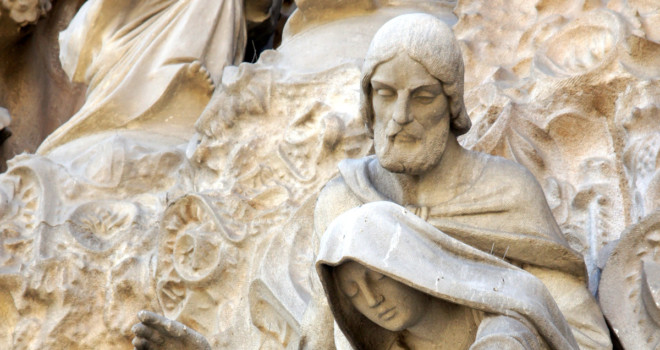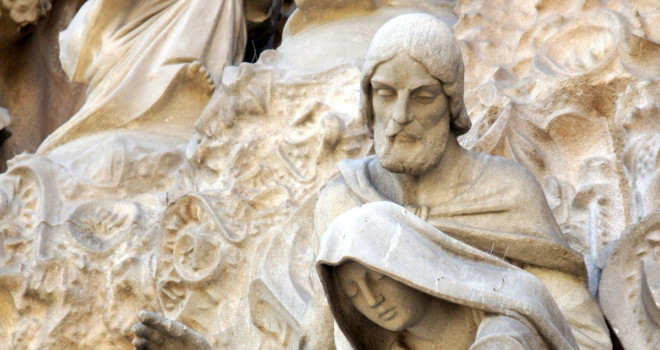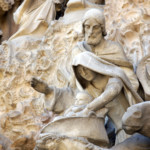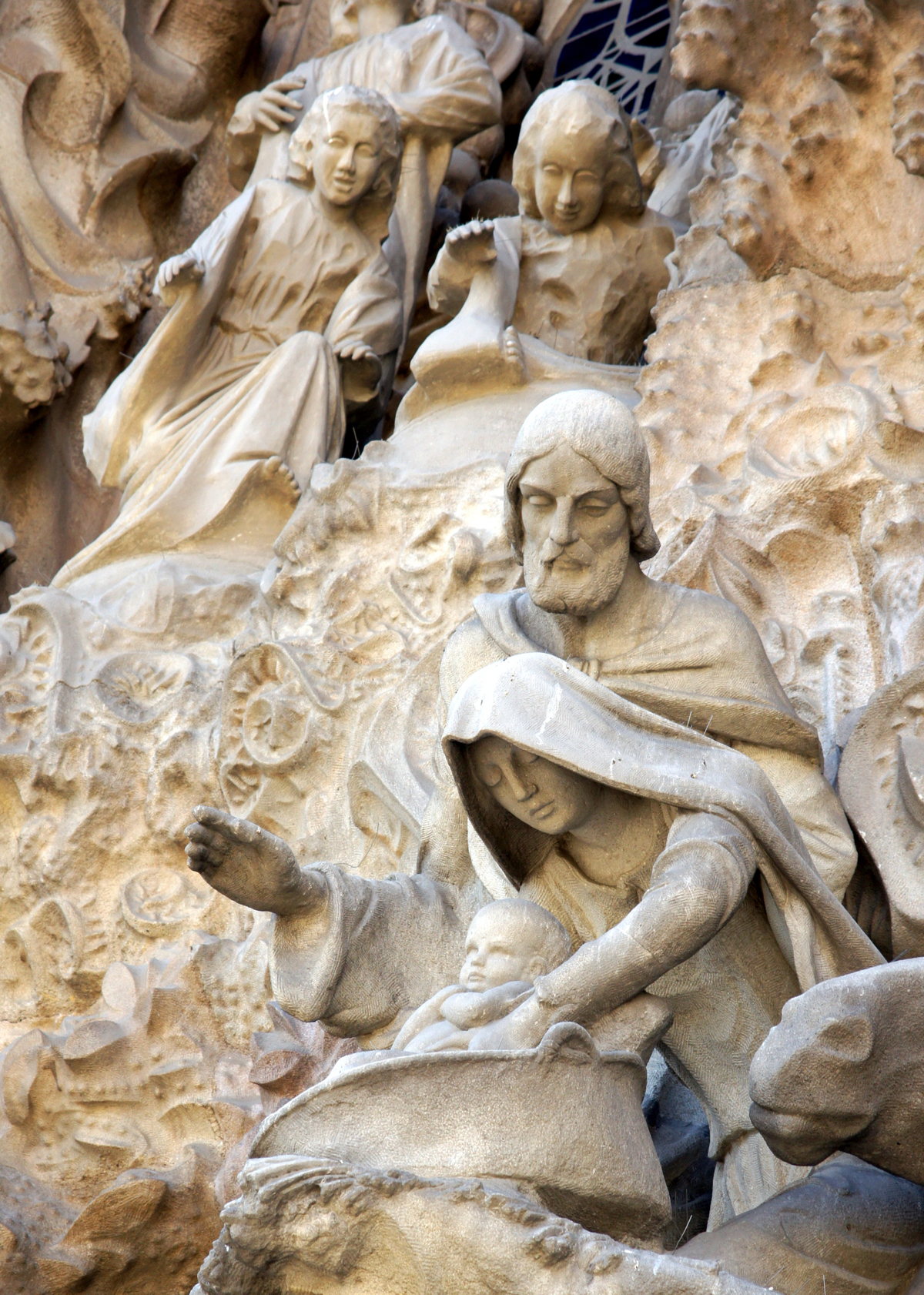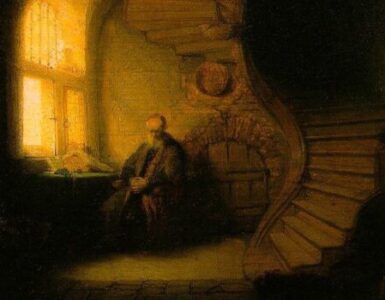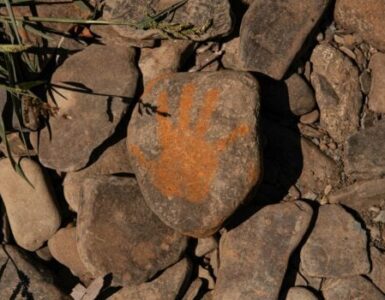Among the precious treasures of the Church that bring about the salvation of souls, which we must recover to save our families and rebuild a Christian society, is the Sacrament of Matrimony. Is it not darkened today above all because we rarely proclaim this forgotten gem among the seven sacraments, no longer let it shine in our lives? Hope rises in what is probably the most improbable phenomenon of our time, the construction of the Sagrada Família, the Expiatory Church of the Holy Family, right in the middle of the modern metropolis of Barcelona.
Crypt – The Root of the Sagrada Família
The crypt is the oldest part of the Sagrada Família, its spiritual root. Conceived rather conventionally by del Villar, Gaudí completed it as early as 1889 and left his mark on it. Its rapid completion and the noble character of the crypt, which could serve as a parish church, secured Gaudí the admiration and trust of his clients. This gives him time to completely rethink the overall design of the Sagrada Família. Even today, the crypt is used steadily for religious services, including confessions, many of which are located here in the side chapels. One chapel is dedicated to Our Lady of Montserrat. In the chapel of Our Lady of Mount Carmel is Gaudí’s tomb under the touching statue of the Virgin Mary that he himself created.
On June 7, 1926, Gaudí was hit by a streetcar on his way from his morning mass at the Oratory of St. Philip Neri in the middle of the Barri Gòtic to the construction site of the Sagrada Família, where he had been sleeping. Because of his worn clothes, the seriously injured man was mistaken for a beggar. Only after hours did he arrive at the Hospital for the Poor de la Santa Creu. Three days later, his closest collaborator Sugrañes and the chaplain of the Sagrada Família found him there. Thus Gaudí’s often expressed wish for a “good death” was fulfilled, to die as a poor man surrounded by poor people and to be taken in out of pure charity. On June 10, after the anointing of the sick and the devout reception of Holy Communion, he died fully conscious. His last words were: “Amen. Amen. My God, my God!”
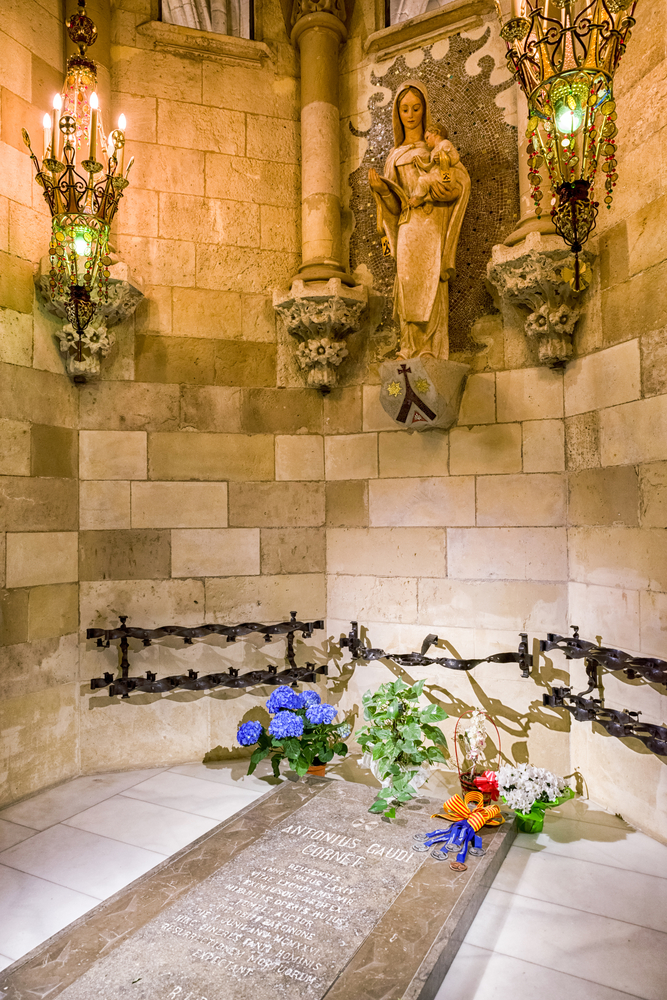
His funeral was a gigantic triumph. Many thousands of people from all ages and stages of life paid their last respects to him. With the permission of Pope Pius XI (1857-1939), Antoni Gaudí found his final resting place in the place where he had worked the longest in his life. Gaudí, who never married, cared for his father—who lived a very long time—and his orphaned, invalid niece. They formed his small family.
Soon there was a call for Gaudí’s beatification. But it was not until 1992 that an association was founded with this goal and archdiocesan support. On the feast of St. Joseph in 1998, the association restored Gaudí’s tomb, which was devastated during the Spanish Civil War. Sotoo created an alms box to collect donations for this purpose. It represents Gaudí’s designs for the schools of the Sagrada Família, placed in the intersection of the three hearts of Jesus, Mary and Joseph. In addition, writings inform the visitor about amazing answers to prayer and recommend a prayer for Gaudí’s intercession:
God, our Father, You have given Your servant, the architect
Antoni Gaudí, a great love for Your creation
and a burning desire to imitate the mysteries of the
Childhood and the Sufferings of the Son of God. Give,
by the grace of the Holy Spirit, that I too may succeed
to devote myself to a job well done, and glorify
Your servant Antoni by granting me my request …
through his intercession.
I ask this through Christ our Lord, Amen.
Jesus, Mary and Joseph, obtain peace for us and protect the family! (three times).
St. Joseph, Patron of the Entire Church
What were the spiritual roots of the idea of building an Expiatory Church of the Holy Family? The tomb of the bookseller and editor Josep Maria Bocabella i Verdaguer (1815-1892) in the Capella del Sant Crist of the crypt gives a clue.
In 1864, Pius IX had published his encyclical Quanta cura, which was directed against social aberrations. As Syllabus errorum, its appendix condemns errors of modernity, such as rationalism, liberalism, freemasonry, socialism and communism, whose spiritual overcoming is yet to be. Concerned about the spiritual crisis of his time, Bocabella founded two years later the Associació de Devots de Sant Josep for the veneration of Saint Joseph, of whom the liturgy says: “Him, Your faithful and prudent servant, You have set over Your family, so that he might guard Your only-begotten Son in place of father…” On December 8, 1870, Pius IX proclaimed St. Joseph the patron saint of the universal Church, which Pope Francis (b.1936) followed up on in the midst of the coronavirus crisis: “So let us now implore from St. Joseph the grace of all graces – our conversion”. For the “Year of St. Joseph 2021”, in view of the coronavirus crisis, a plenary indulgence is extended to those “who, for legitimate reasons, cannot leave their homes”.
Gaudí’s spiritual connection with St. Teresa of Avila (1515-1582) grew out of his friendship with the priest Enrique de Ossó y Cervelló (1840-1896), canonized in 1993, who in 1873 founded the Hijas de María Inmaculada y Santa Teresa de Jesús, a congregation of sisters dedicated to the education of youth. In 1888, Enrique d’Ossó commissioned Gaudí to build the Col legi de les Teresianes in Sant Gervasi de Cassoles (now a neighborhood of Barcelona). The spiritual arc thus stretches from the confidence of the “great” Theresa of Avila that “every grace asked of St. Joseph will surely be granted” to the “little” Theresa of Lisieux (1873-1897), who since her childhood felt “a great devotion to St. Joseph, which coincided with my love for the Blessed Mother.”
Bocabella was allied with the artist-priest Josep Manyanet i Vives (1833-1901). Pope John Paul II. (1920-2005) canonized him in 2004, paying tribute to his apostolic zeal for the construction of the Sagrada Familia. Two years earlier Manyanet had founded the Congregation of the Fills de la Sagrada Família, the Sons of the Holy Family, followed by the ‘Missionary Daughters of the Holy Family’ (1874). His work grew rapidly, establishing schools throughout Catalonia, especially for workers’ children in industrial neighborhoods. Devotion to the Holy Family was central: “Our centers are called ‘of the Holy Family’ because Jesus, Mary and Joseph are not only the patrons and protectors, but also the model we imitate in virtue and firm love of work. For this was the main goal of Jesus’ hidden life in the humble house of Nazareth.” In its spiritual dimension, the Sagrada Família apparently has two other fathers, Bocabella and Manyanet.
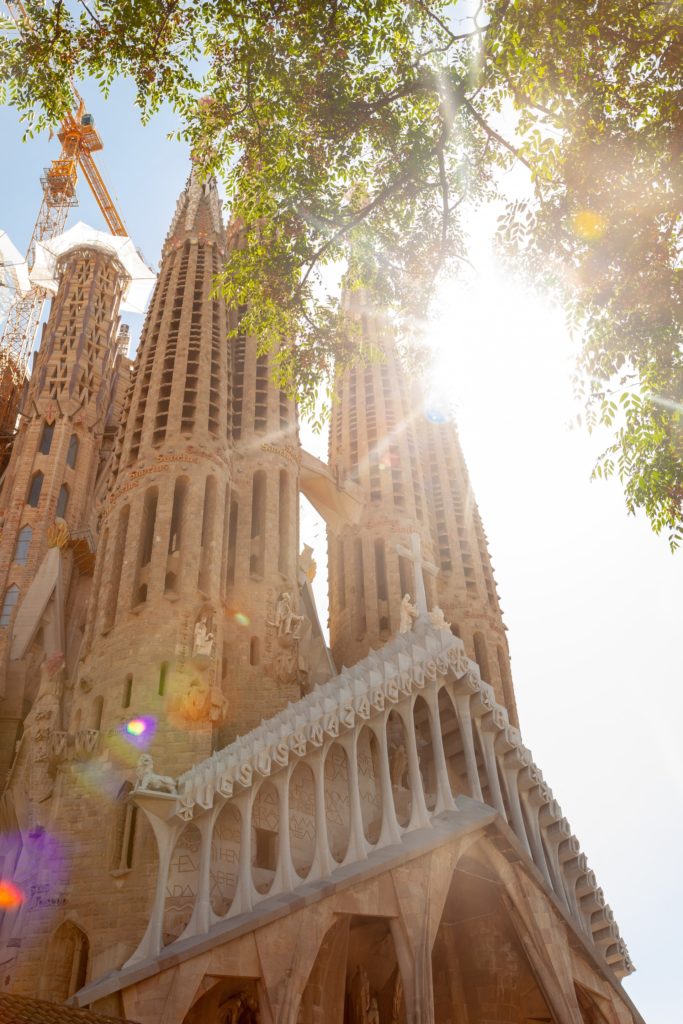
St. Joseph, cornerstone of the Sagrada Família
Bocabella struck a chord with the Catholics of his time. Within a few years, his Associació de Devots de Sant Josep grew to over 600,000 members. In the same year, the first issue of his magazine El Propagador de la Devoción a San José was published, and its first edition of 25,000 copies was sold out almost immediately. Bocabella was inspired by the charismatic Salesian priest Jean-Joseph Huguet (1812-1884), who published a magazine of the same name from Dijon, wrote countless biographies of the saints and, among other things, made the spectacular conversions of the later cardinals John Henry Newman (1801-1890) and Henry Edward Manning (1808-1892) known to a wide reading public. Above all, he recommended St. Joseph as a great advocate of seemingly hopeless causes.
Gaudí’s friend and collaborator, the Symbolist painter Aleix Clapés i Puig (1850-1920), whose religious paintings are still moving today, shows Bocabella almost ready to leap at his desk with the gaze of a visionary, as if he wanted to go into a spiritual battle with the quill pen as a weapon. In his own way, Bocabella anticipates the answer to the question that Pope Leo XIII (1810-1903) pursued in his encyclical on St. Joseph: “Why, then, was St. Joseph given the special honor of patron saint of the Church?” As a model of humility and holiness, who at the same time radiates paternal authority, working lay people especially can orient themselves to St. Joseph. When in Bocabella and Manyanet the idea of an Expiatory Church of the Holy Family matured, Barcelona, like many cities of industrialization, was afflicted by great plagues: yellow fever, cholera and outbreaks of other infectious diseases, coupled with abject poverty, famine, overpopulation, high infant mortality, alcoholism, morphine addiction, domestic violence, and prostitution that reached epidemic proportions. Added to this were the increasingly frequent bomb attacks by anarchists.
The ball was set rolling by Josep Manyanet, who, like his namesake and role model, found joy and fulfillment in sculpture, fine marquetry and his passion for carpentry, for which Gaudí provided him with professional tools. Manyanet’s ideas about the nobility of manual labor, its debasement by industrial machine production, and its ability to lead the soul closer to God had parallels. For example, his English contemporaries John Ruskin (1819-1900) and William Morris (1834-1896) founded the Arts and Crafts Movement. At Bocabella’s request, Manyanet made a portable altar for Josep Caixal i Estradé (1803-1879), Bishop of Urgell, who helped shape the First Vatican Council.
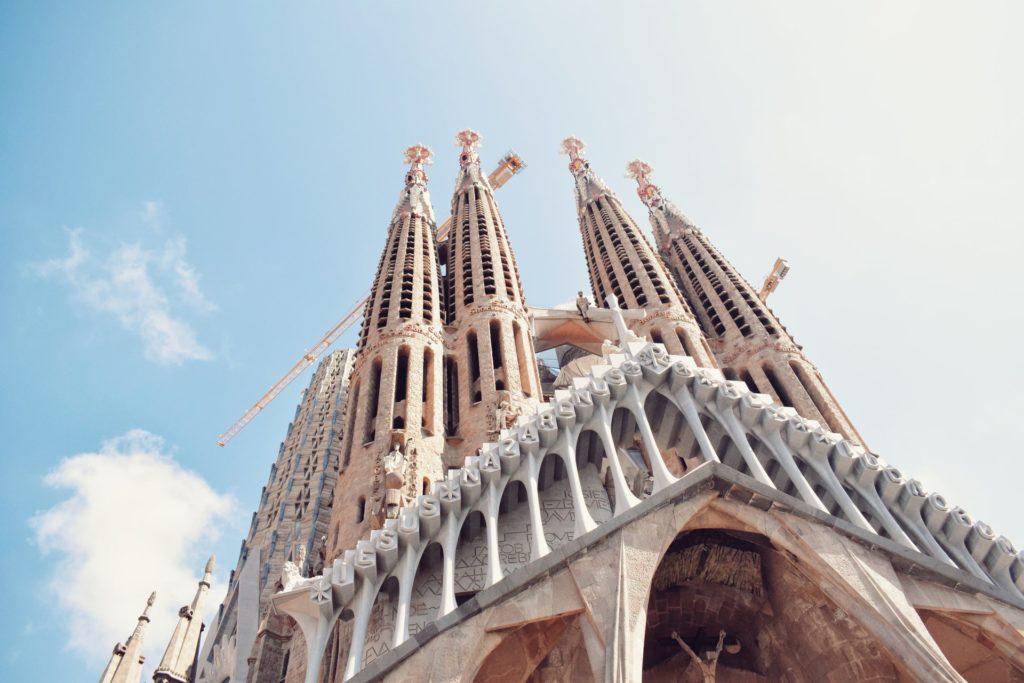
This bishop helped Bocabella get an audience with Pius IX when he went on a pilgrimage to Rome in November 1871 to win papal approval for the construction of the Church of the Atonement, to be built entirely from the “donations of sinners”, in which “sin and suffering will be transformed into faith and salvation.” His original idea was to build a church like the one in Loreto, including a faithful copy of the house of the Holy Family that had been demolished by returning Crusaders in Nazareth and rebuilt in Loreto, Italy. As a sign of his personal support and sympathy, Pius IX gave Bocabella a silver chalice. As early as 1877, the Asociación de Devotos de San José had collected enough funds to ask del Villar, who had become the official diocesan architect, for plans. The idea of taking Loreto as a model, however, failed due to del Villar’s resistance.
Finally, the foundation stone of the Sagrada Família is laid on March 19, 1882, in a solemn ceremony attended by the bishops of Barcelona and Vic, high ecclesiastical and secular dignitaries, Manyanet and Bocabella. In a moving gesture, Bocabella gives Manyanet the silver chalice of Pius IX that was used at the inauguration Mass. The young Gaudí also participated in the laying of the foundation stone of the building, for which he was to take responsibility just one year later.
✠
Editor’s note: This article is the fourth part in our special series, A Symbol of Rediscovered Faith: The Expiatory Church of the Holy Family in Barcelona. You can click here to see the full series or begin here at part one.
image: Detail of the Nativity facade Sagrada Familia created by Gaudi by Chantal de Bruijne / Shutterstock.com


